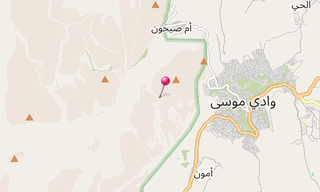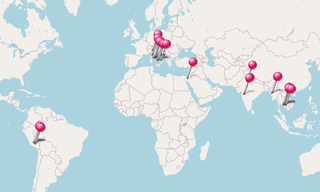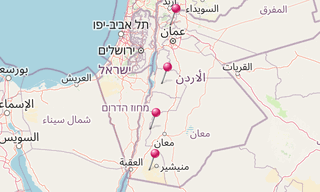Petra, originally known to the Nabataeans as Raqmu, is a historical and archaeological city in southern Jordan. The city is famous for its rock-cut architecture and water conduit system. Another name for Petra is the Rose City due to the color of the stone out of which it is carved.
Petra is one of the New seven Wonders of the World. Established possibly as early as 312 BC as the capital city of the Arab Nabataeans, it is a symbol of Jordan. The Nabataeans were nomadic Arabs who took advantage of Petra’s proximity to regional trade routes to establish it as a major trading hub.
The Nabataeans are also known for their great ability in constructing efficient water-collecting methods in the barren deserts and their talent in carving structures into solid rocks. Petra lies on the slope of Jebel al-Madhbah (identified by some as the biblical Mount Hor) in a basin among the mountains which form the eastern flank of Arabah (Wadi Araba), the large valley running from the Dead Sea to the Gulf of Aqaba.
The site remained unknown to the Western world until 1812, when it was introduced by Swiss explorer Johann Ludwig Burckhardt.
Main sights
Al Barid, Al Deir, Byzantine Church, Djin Blocks, Carmin Facade, Corathian Tomb, Garden Tomb, Khazneh, Lion Triclinium, Obelisk Tomb, Palace Tomb, Roma Soldier Tomb, Silk Tomb, Street of Facades, Theater, Tomb 69, Uneishu Tomb, Urn Tomb, Wadi Musa, Wadi Muthlim

-Al-Deir.hero.landscape.jpg?w=1600)

-Khazneh.jpg?w=256)
-Garden-Tomb.jpg?w=256)
-Urn-Tomb.jpg?w=256)
-Silk-Tomb.jpg?w=256)
-Theater.jpg?w=256)
-Palace-Tomb.jpg?w=256)
.jpg?w=256)
-Carmine-Facade.jpg?w=256)
-Urn-Tomb.jpg?w=256)
-Roman-Soldier-Tomb.jpg?w=256)
-Silk-Tomb.jpg?w=256)
.jpg?w=256)
-Uneishu-Tomb.jpg?w=256)
.jpg?w=256)
.jpg?w=256)
-Serapide.jpg?w=256)
-Silk-Tomb.jpg?w=256)
-Theater.jpg?w=256)
.jpg?w=256)
-Al-Barid.jpg?w=256)
-Umm-al-Biyara.jpg?w=256)
-Carmine-Facade.jpg?w=256)
-Khazneh.jpg?w=256)
-Khazneh.jpg?w=256)
-Al-Deir.jpg?w=256)
-Khazneh.jpg?w=256)
.jpg?w=256)
-Urn-Tomb.jpg?w=256)
.jpg?w=256)
-Palace-Tomb.jpg?w=256)
-Al-Barid.jpg?w=256)
-Silk-Tomb.jpg?w=256)
-Khazneh.jpg?w=256)
-Roman-Soldier-Tomb.jpg?w=256)
.jpg?w=256)
-Corinthian-Tomb.jpg?w=256)
-Djin-Blocks.jpg?w=256)
-Wadi-Muthlim.jpg?w=256)
-Al-Barid.jpg?w=256)
-Al-Deir.jpg?w=256)
-Palace-Tomb.jpg?w=256)
.jpg?w=256)
-Al-Barid.jpg?w=256)
-Lion-Triclinium.jpg?w=256)
-Urn-Tomb.jpg?w=256)
-Khazneh.jpg?w=256)
-Khazneh.jpg?w=256)
.jpg?w=256)
-Khazneh.jpg?w=256)
.jpg?w=256)
-Al-Deir.jpg?w=256)
-Silk-Tomb.jpg?w=256)
-Urn-Tomb.jpg?w=256)
-Khazneh.jpg?w=256)
-Umm-al-Biyara.jpg?w=256)
-The-Arched-Gate.jpg?w=256)
-Al-Deir.jpg?w=256)
-Urn-Tomb.jpg?w=256)
-Khazneh.jpg?w=256)
.jpg?w=256)
-Al-Deir.jpg?w=256)
-Khazneh.jpg?w=256)
-Lion-Triclinium.jpg?w=256)
-Street-of-Facades.jpg?w=256)
.jpg?w=256)
-Street-of-Facades.jpg?w=256)
.jpg?w=256)
-Silk-Tomb.jpg?w=256)
-Uneishu-Tomb.jpg?w=256)
-Al-Barid.jpg?w=256)
-Corinthian-Tomb.jpg?w=256)
-Urn-Tomb.jpg?w=256)
-Tomb-69.jpg?w=256)
-Al-Barid.jpg?w=256)
-Khazneh.jpg?w=256)
-Khazneh.jpg?w=256)
-Khazneh.jpg?w=256)
-Silk-Tomb.jpg?w=256)
-Wadi-Muthlim.jpg?w=256)
-Khazneh.jpg?w=256)
-Uneishu-Tomb.jpg?w=256)
-Khazneh.jpg?w=256)
-Urn-Tomb.jpg?w=256)
-Palace-Tomb.jpg?w=256)
-Al-Barid.jpg?w=256)
-Khazneh.jpg?w=256)
-Carmine-Facade.jpg?w=256)
-The-Arched-Gate.jpg?w=256)
-The-Arched-Gate.jpg?w=256)
-Palace-Tomb.jpg?w=256)
-Al-Barid.jpg?w=256)
.jpg?w=256)
-Djebel-Attof.jpg?w=256)
-Al-Deir.jpg?w=256)
-Al-Deir.jpg?w=256)
-Street-of-Facades.jpg?w=256)
-Umm-al-Biyara.jpg?w=256)
-Street-of-Facades.jpg?w=256)
.jpg?w=256)
-Khazneh.jpg?w=256)
-Lion-Triclinium.jpg?w=256)
.jpg?w=256)
-Al-Deir.jpg?w=256)
-Al-Deir.jpg?w=256)
-Corinthian-Tomb.jpg?w=256)
.jpg?w=256)
-Al-Deir.jpg?w=256)
-Lion-Triclinium.jpg?w=256)
-Uneishu-Tomb.jpg?w=256)
-Urn-Tomb.jpg?w=256)
-Khazneh.jpg?w=256)
-Khazneh.jpg?w=256)
-Al-Barid.jpg?w=256)
.hero.jpg?w=320)

-Khazneh.hero.jpg?w=320)

.hero.jpg?w=320)
.map.png)